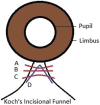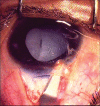Factors affecting surgically induced astigmatism in manual small-incision cataract surgery
- PMID: 36308096
- PMCID: PMC9907311
- DOI: 10.4103/ijo.IJO_1034_22
Factors affecting surgically induced astigmatism in manual small-incision cataract surgery
Abstract
Cataract is the most common cause of avoidable blindness in the world. While cataract surgery is continually evolving, manual small-incision cataract surgery (MSICS) still remains highly relevant, especially with the threat of the coronavirus disease 2019 (COVID-19) still looming large over the world. MSICS today has a renewed significance, since it does not involve the use of any advanced machinery and relies mainly on easily sterilizable instruments, thereby making it a safe and inexpensive option. A self-sealing valvular tunnel entry forms the basis of MSICS, and proper positioning and construction of the tunnel is imperative to the success of the surgery. With more and more people demanding spectacle independence after surgery, it becomes important to have a thorough understanding of the factors that may influence surgically induced astigmatism in MSICS. These include the incision location, size and shape, configuration of the sclero-corneal tunnel, pre-existing ocular pathology, role of sutures, amongst others. With proper knowledge, many of these factors can be modulated to achieve best results.
Keywords: Astigmatism; MSICS; cataract surgery; incision construction; surgically induced astigmatism.
Conflict of interest statement
None
Figures




Similar articles
-
Postoperative astigmatic considerations in manual small-incision cataract surgery - A review.Indian J Ophthalmol. 2022 Nov;70(11):3785-3790. doi: 10.4103/ijo.IJO_1627_22. Indian J Ophthalmol. 2022. PMID: 36308097 Free PMC article. Review.
-
A comparative study of sclero-corneal and clear corneal tunnel incision in manual small-incision cataract surgery.Nepal J Ophthalmol. 2011 Jan-Jun;3(1):19-22. doi: 10.3126/nepjoph.v3i1.4273. Nepal J Ophthalmol. 2011. PMID: 21505541 Clinical Trial.
-
Comparison of surgically induced astigmatism between horizontal and X-pattern sutures in the scleral tunnel incisions for manual small incision cataract surgery.Indian J Ophthalmol. 2015 Jul;63(7):606-10. doi: 10.4103/0301-4738.167113. Indian J Ophthalmol. 2015. PMID: 26458479 Free PMC article. Clinical Trial.
-
Re-inventing the straight incision with a single central suture in manual small-incision cataract surgery to minimize surgically induced astigmatism.Indian J Ophthalmol. 2022 Nov;70(11):3875-3878. doi: 10.4103/ijo.IJO_1533_22. Indian J Ophthalmol. 2022. PMID: 36308118 Free PMC article.
-
Complications of manual small-incision cataract surgery.Indian J Ophthalmol. 2022 Nov;70(11):3803-3811. doi: 10.4103/ijo.IJO_1812_22. Indian J Ophthalmol. 2022. PMID: 36308100 Free PMC article. Review.
Cited by
-
Topographic and surgical risk factors for high postoperative residual astigmatism after small incision lenticule extraction in patients with different degrees of myopia: a retrospective cohort study.BMC Ophthalmol. 2024 Jan 29;24(1):45. doi: 10.1186/s12886-024-03296-x. BMC Ophthalmol. 2024. PMID: 38287289 Free PMC article.
-
Manual small incision cataract surgery: An ergonomic solution to tackle cataract backlog and challenging situations.World J Methodol. 2025 Dec 20;15(4):104529. doi: 10.5662/wjm.v15.i4.104529. eCollection 2025 Dec 20. World J Methodol. 2025. PMID: 40900862 Review.
-
Vector analysis valuation of astigmatism in the cornea after femtosecond laser-assisted corneal astigmatism incision in cataract surgery.BMC Ophthalmol. 2025 May 28;25(1):318. doi: 10.1186/s12886-025-04145-1. BMC Ophthalmol. 2025. PMID: 40437417 Free PMC article.
-
Long-Term Clinical and Structural Outcomes Following Iris-Claw IOL Exchange for Dislocated Intraocular Lenses.J Clin Med. 2025 May 9;14(10):3306. doi: 10.3390/jcm14103306. J Clin Med. 2025. PMID: 40429308 Free PMC article.
-
Examination of Vitreolenticular Interface in Relation to Different Phacoemulsification Parameters in Early and Late Postoperative Period.J Clin Med. 2024 Aug 17;13(16):4855. doi: 10.3390/jcm13164855. J Clin Med. 2024. PMID: 39200997 Free PMC article.
References
-
- GBD 2019 Blindness and Vision Impairment Collaborators;Vision Loss Expert Group of the Global Burden of Disease Study. Causes of blindness and vision impairment in 2020 and trends over 30 years, and prevalence of avoidable blindness in relation to VISION 2020:The Right to Sight:An analysis for the Global Burden of Disease Study. Lancet Glob Health. 2021;9:e144–60. - PMC - PubMed
-
- Venkatesh R, Tan CS, Sengupta S, Ravindran RD, Krishnan KT, Chang DF. Phacoemulsification versus manual small-incision cataract surgery for white cataract. J Cataract Refract Surg. 2010;36:1849–54. - PubMed
-
- Jaggernath J, Gogate P, Moodley V, Naidoo KS. Comparison of cataract surgery techniques:Safety, efficacy, and cost-effectiveness. Eur J Ophthalmol. 2014;24:520–6. - PubMed
-
- Colvard DM, Kratz RP, Mazzocco TR, Davidson B. Clinical evaluation of the Terry surgical keratometer. J Am Intraocul Implant Soc. 1980;6:249–51. - PubMed
Publication types
MeSH terms
LinkOut - more resources
Full Text Sources
Medical

